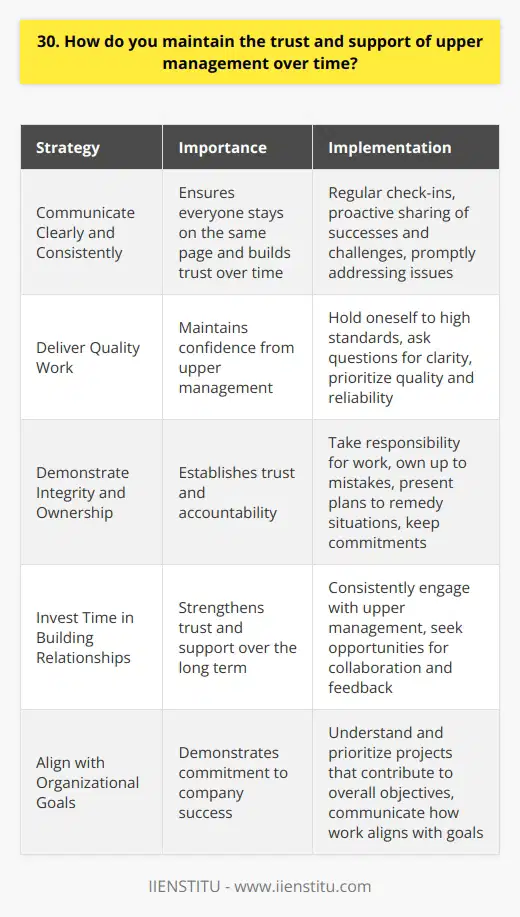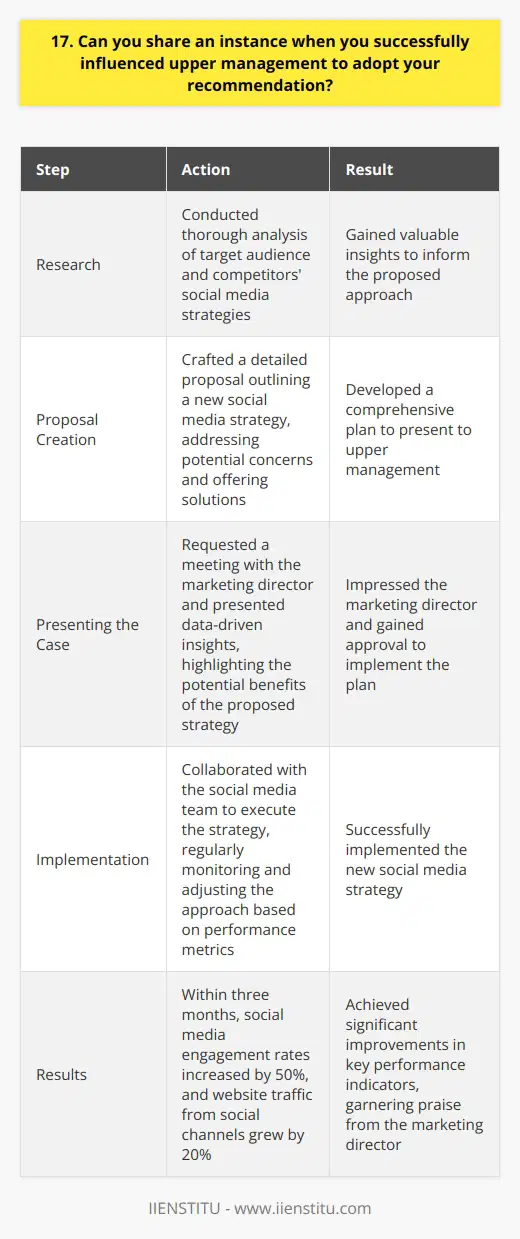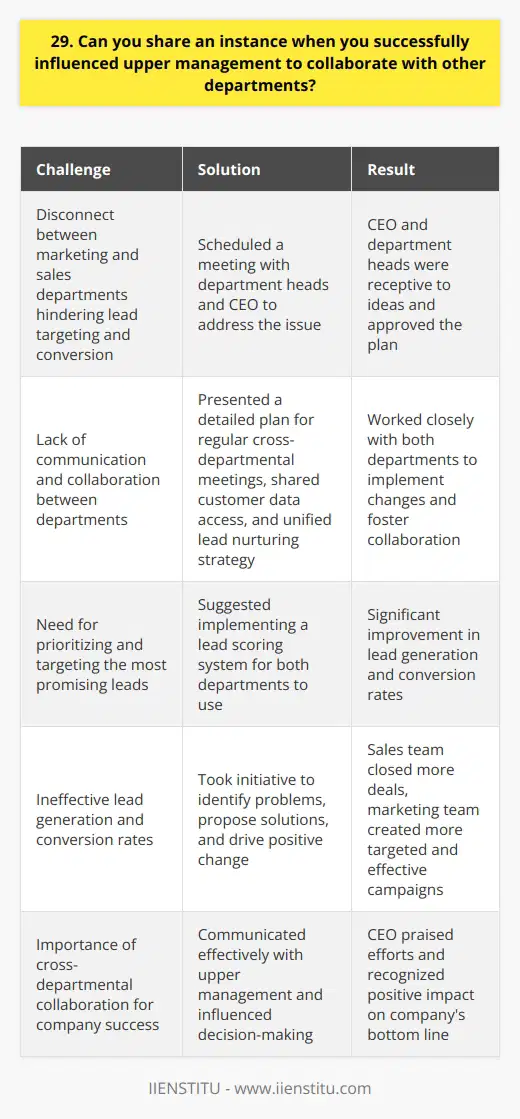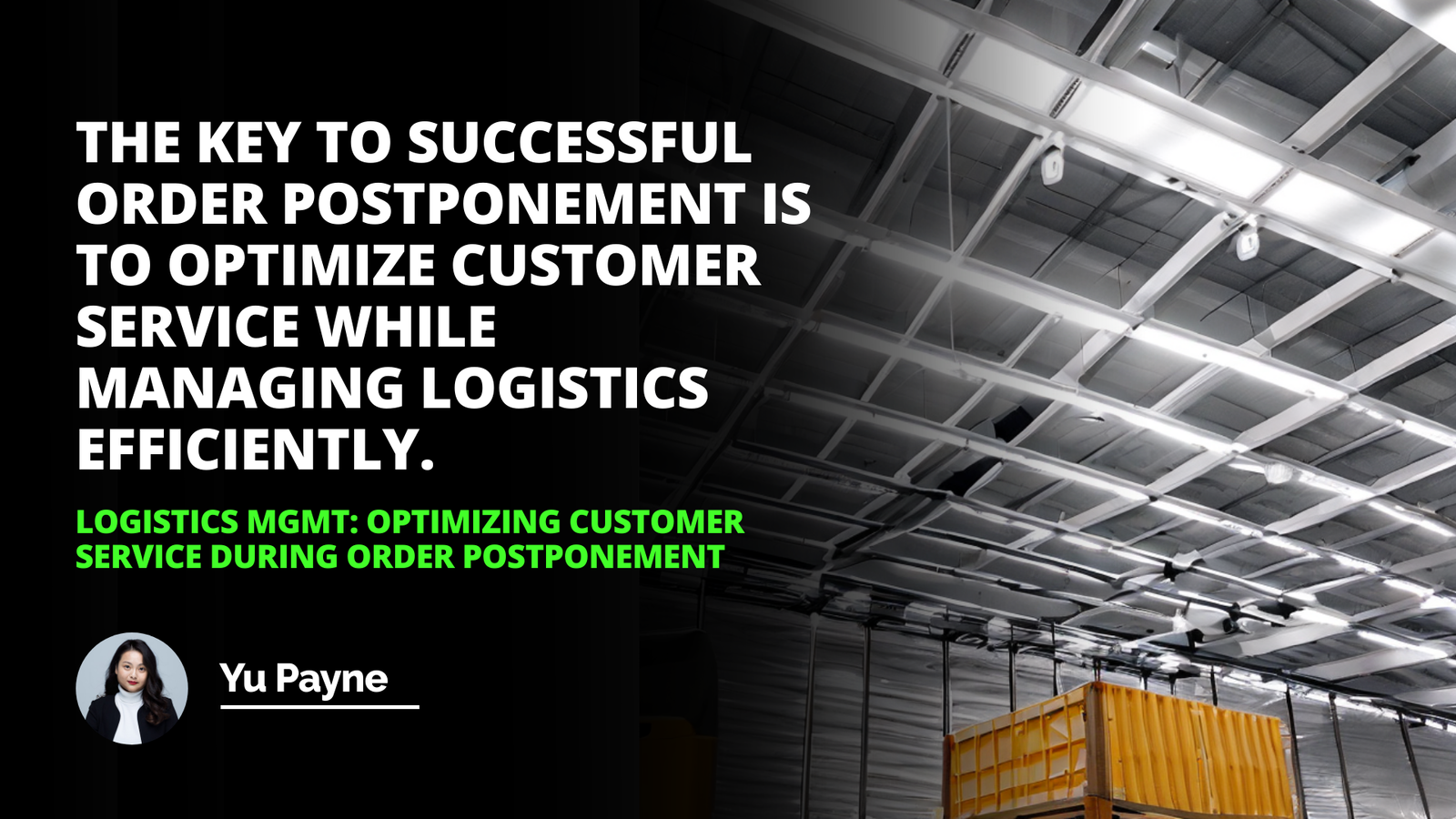
The question, "Persuaded upper management?" seems relatively simple, but it holds profound significance. A potential employer asks this question to evaluate your critical thinking abilities, strategic influencing skills, resilience, and how you navigate hierarchical channels.
Intrinsically, this question serves as a quantifiable yardstick for assessing your capacity to inculcate change and progress within operational parameters.
Hence, the interviewer is intent on understanding not just if you can persuade decision-makers, but how you achieve the feat!
The Purpose of the Question: Persuaded upper management?
The core intent behind "persuaded upper management?" lies in uncovering your narratives about influencing powers-that-be and driving strategic resolutions.
The question aims to reveal your ability to handle complex situations, create consensus, and negotiate with people in higher positions.
It also is a way to evaluate your interpersonal skills, persistence, and how well you understand the cogs that drive an organizational system.
At What Interview Level is "Persuaded Upper Management?" Asked?
Often, the query about having "persuaded upper management?" is posed at mid-to-senior leadership level interviews. Here, the ability to influence decision or policy at executive levels can directly impact organizational direction and outcomes.
Interview Question: How Does Your Time Management Change When Stressed?
Interview Question: Share a Time Management Success Story From Your Professional Journey.
Related Course: Leadership Course Online
However, it can be posed at any stage where the role demands liaising with decision-makers for approvals or facilitating organizational changes.
What Kind of Answer is Expected from the Candidate?
A well-structured, articulate, and evidence-based narrative is expected in response to "persuaded upper management?".
Your story should encompass a clear context, your actions, and the result of your persuasion efforts.
Pick a compelling example that demonstrates your tenacity, clear communication, problem-solving skills and, crucially, the positive impact of your influence on the organization's growth.
Possible Answers to Consider
To skillfully answer "persuaded upper management?", focus on a significant change you initiated that needed approval from the top.
Start with the issue you identified and why you believed change was necessary. Enumerate how you gathered support for your proposal, your strategy for presenting your ideas to upper management, and how you countered any resistance.
Cap it off by highlighting the beneficial impacts of your managed influence.
For instance
You could say: "In my previous role at XYZ Corp, I noticed that our client retention rate was declining progressively. I attributed it to our outdated customer service policies.
So I came up with a comprehensive strategy that involved integrating a AI-powered customer service solution. This element was a stretch because of budget constraints and the company’s reluctance for novel tech-adoption.
I compiled data-supported arguments and potential long-term benefits to present to the upper management. To my satisfaction, my relentless communication and persuasion resulted in the approval of my proposed solution. Six months post-implementation, we experienced a 40% grow in our customer retention rate."
When grappling with "persuaded upper management?", remember to showcase your skills of persuasion as a powerful combination of analytical reasoning, strong communication, and a knack for building professional relationships.
Use your storytelling capabilities wisely to paint a vivid picture of your capacity to elicit change at scale, seal your reputation as a persuasive intrapreneur, and grab that dream job!
Unquestionably, the journey through this process of answering "persuaded upper management?" is itself a persuasion, one where you expertly influence your potential employer to realize that you are indeed the perfect fit!
Instances of Successful Persuasion of Upper Management
Methods Utilized in Persuading Upper Management
Impacts and Results of Persuading Upper Management
Similar interview questions:
Have you ever convinced the higher authorities in your workplace?
Did you manage to influence the decision of the upper management?
How frequently have you persuaded management to accept your ideas?
Can you share instances where you succeeded in persuading the upper management?
Have you ever gotten the upper management to see things from your perspective?
Have you ever managed to sway the decisions of your senior management?
Have you been successful in convincing your company's top management?
How proficient are you in persuading your senior management regarding important matters?
Were your persuasion skills effective with the upper management?
Are there situations where you influenced the decision-making of the higher-ups in the organization?
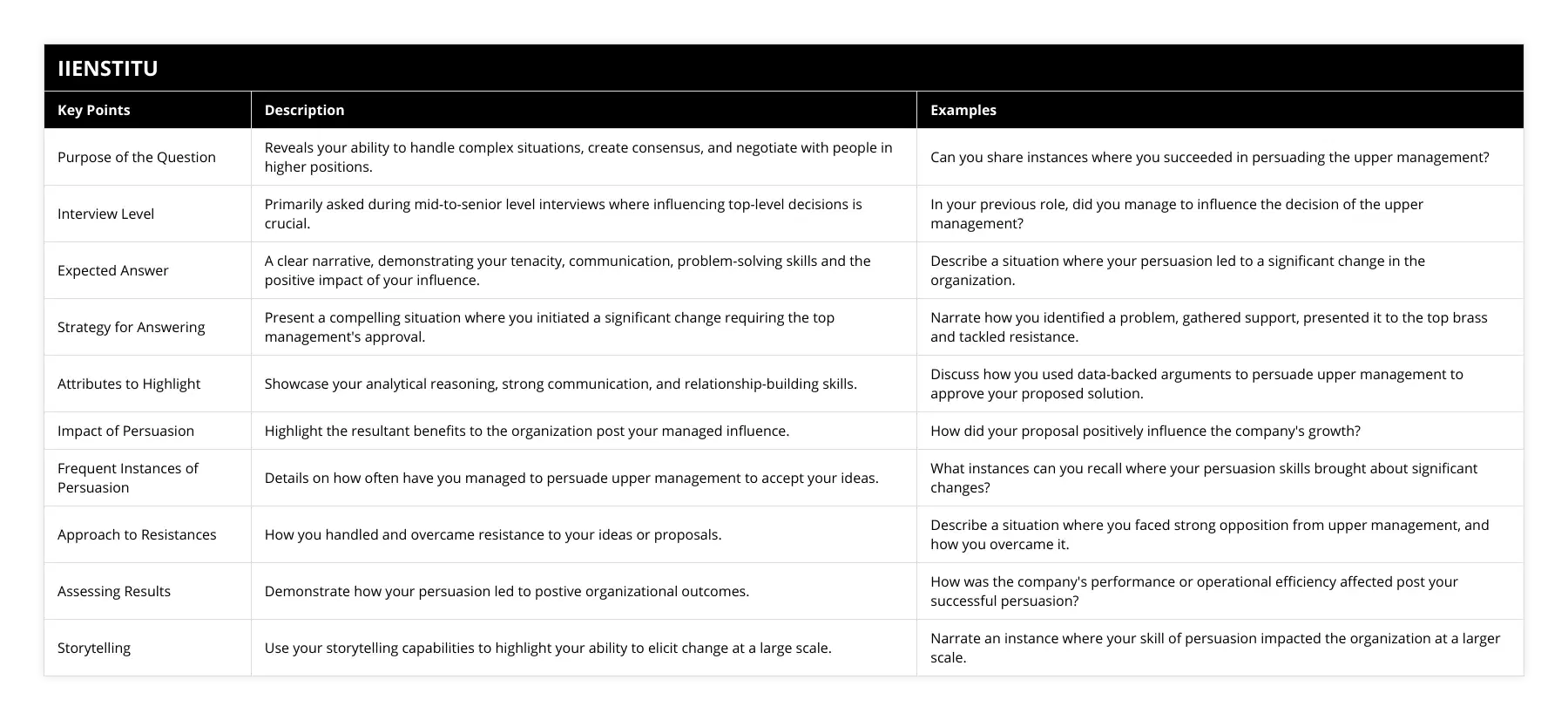
Frequently Asked Questions
1. How have you influenced executive decisions?
Collaborative Decision Making
I've always believed in the power of collaboration when it comes to making important decisions. In my previous role, I worked closely with the executive team to provide insights and recommendations based on data analysis and market research. By presenting a clear and compelling case, I was able to influence key strategic decisions that helped drive the company's growth and success.
Effective Communication
One specific example that comes to mind is when I led a cross-functional team to evaluate a potential acquisition opportunity. I worked diligently to gather and analyze relevant data, and then presented my findings to the executive team in a clear and concise manner. By effectively communicating the potential risks and benefits, I was able to help guide the decision-making process and ultimately influence the outcome.
Building Trust and Credibility
I believe that the key to influencing executive decisions is building trust and credibility over time. By consistently delivering high-quality work and demonstrating a deep understanding of the business, I've been able to earn the respect and trust of senior leaders. This has allowed me to have a greater impact on strategic decisions and contribute to the overall success of the organization.
In summary, I've found that the most effective way to influence executive decisions is through collaboration, effective communication, and building trust and credibility over time. By leveraging these skills, I've been able to make a meaningful impact in my previous roles and am excited to bring that same approach to this new opportunity.
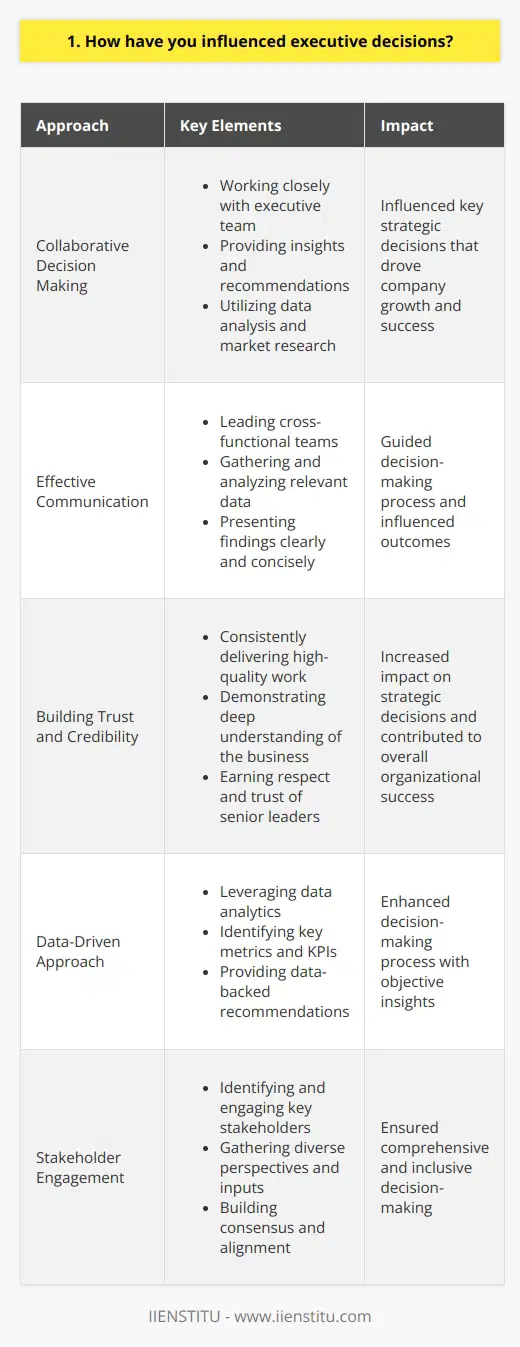
2. Describe a time when you convinced senior leadership to change their stance.
I once convinced my company's senior leadership to change their stance on a critical project decision. I noticed that the current approach wasn't yielding the desired results, so I took the initiative to research alternative solutions.
Gathering Evidence
I spent several weeks gathering data, analyzing case studies, and consulting with experts in the field. I wanted to ensure that my proposal was backed by solid evidence and not just a gut feeling.
Crafting a Compelling Presentation
Armed with the necessary information, I created a detailed presentation highlighting the benefits of the new approach. I focused on how it would improve efficiency, save costs, and ultimately drive better results for the company.
Addressing Concerns and Objections
During the presentation, I anticipated potential concerns and objections from the leadership team. I came prepared with answers and solutions, demonstrating that I had thoroughly thought through the implications of the change.
Building Consensus and Support
I also took the time to individually meet with key stakeholders before the presentation. I listened to their perspectives, addressed their concerns, and sought their support for the proposed change.
The Outcome
Thanks to the comprehensive research, compelling presentation, and proactive stakeholder management, I successfully convinced the senior leadership to adopt the new approach. The project went on to exceed expectations and deliver outstanding results for the company.
This experience taught me the importance of taking initiative, being thorough in my research, and effectively communicating ideas to drive positive change.
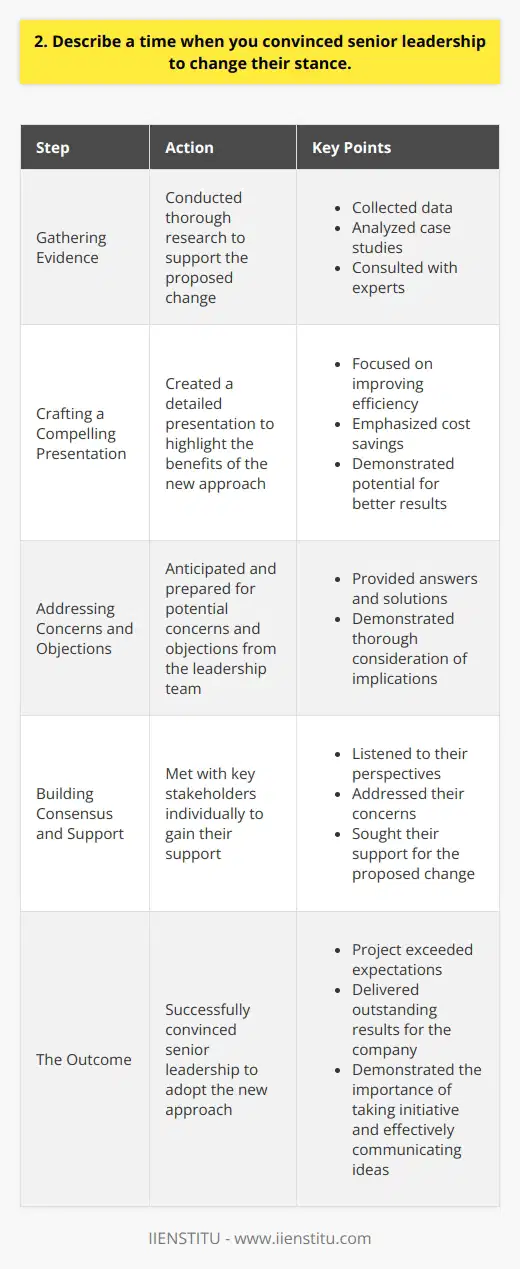
3. Have you ever challenged a decision made by upper management? How did you approach it?
In my previous role, I respectfully challenged a decision made by upper management regarding our marketing strategy. I believed that the proposed plan would not effectively reach our target audience and could potentially waste valuable resources.
Gathering Evidence
Before approaching management, I conducted thorough research to support my perspective. I analyzed market trends, competitor strategies, and customer feedback to build a strong case for an alternative approach.
Presenting My Case
I scheduled a meeting with my supervisor and prepared a clear, concise presentation outlining my concerns and proposed solutions. During the meeting, I maintained a professional and respectful tone, acknowledging the thought that had gone into the original plan.
Collaborating on a Solution
Rather than simply criticizing the decision, I focused on finding a mutually beneficial solution. I openly listened to their perspectives and worked with them to refine my proposal, incorporating their insights and addressing any potential drawbacks.
Outcome and Lessons Learned
As a result of our collaboration, we developed a revised marketing strategy that better aligned with our goals and target audience. This experience taught me the importance of constructively challenging decisions when necessary, backed by research and a solutions-oriented approach. It also reinforced the value of open communication and collaboration in achieving the best outcomes for the company.
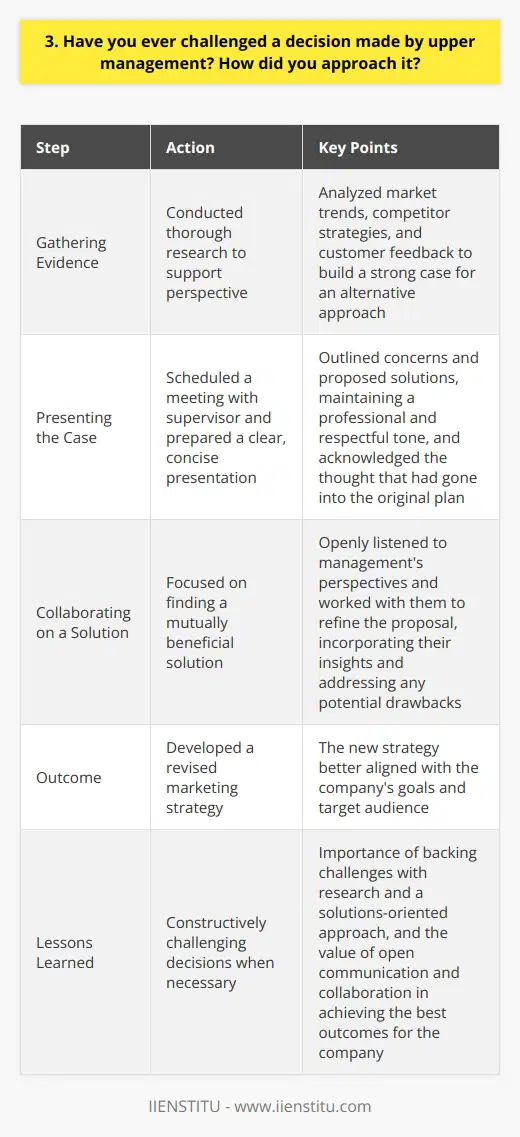
5. How do you communicate with upper management to gain their support?
When communicating with upper management, I focus on being clear, concise, and confident in my message. I start by thoroughly researching the topic and gathering relevant data to support my ideas. This helps me present a well-informed perspective that aligns with the company's goals and objectives.
Building Relationships
I believe in the importance of building strong relationships with upper management. I make an effort to understand their communication style and preferences. Some managers appreciate regular updates via email, while others prefer in-person meetings. By adapting to their preferred method, I ensure that my message is well-received.
Presenting Solutions
When presenting ideas or solutions to upper management, I focus on the benefits to the company. I highlight how my proposal can improve efficiency, reduce costs, or drive growth. By framing my message in terms of business impact, I capture their attention and gain their support.
Listening and Incorporating Feedback
Effective communication is a two-way street. I actively listen to feedback from upper management and incorporate their suggestions into my work. By showing that I value their input, I demonstrate my commitment to collaboration and continuous improvement.
Following Up
After presenting my ideas, I always follow up with upper management. I provide regular updates on progress and keep them informed of any challenges or successes along the way. By maintaining open lines of communication, I build trust and credibility with senior leaders.
Overall, communicating with upper management requires a strategic approach. By being clear, confident, and focused on business impact, I effectively gain their support and drive positive change within the organization.
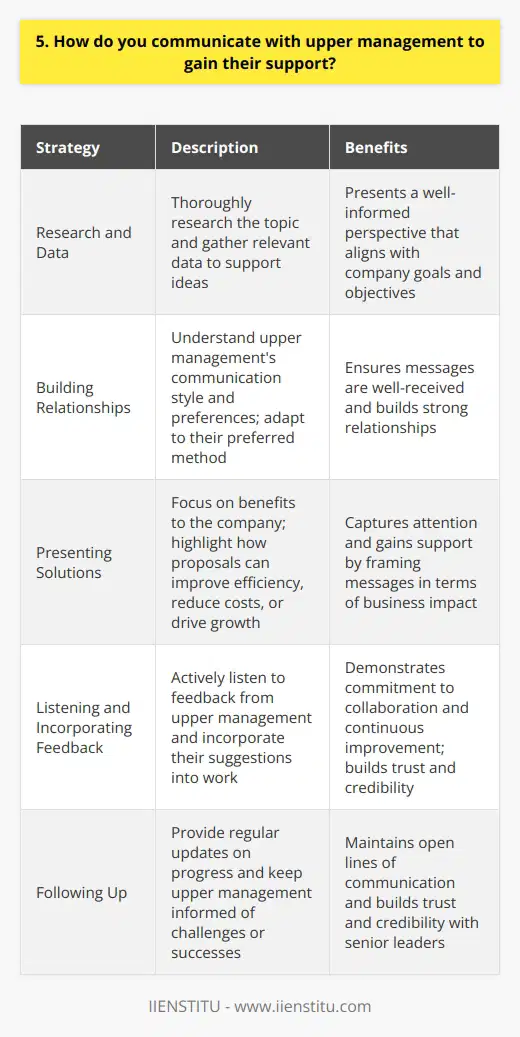
6. What strategies do you use to align your ideas with the company's goals?
When aligning my ideas with the company's goals, I start by thoroughly researching the organization's mission and values. This helps me understand their priorities and how I can contribute. Next, I brainstorm ways to apply my skills and experience to support those objectives.
Communicating with Colleagues
I also make a point to have conversations with colleagues across different departments. Gaining their insights helps me see the bigger picture of how everyone's efforts fit together. Plus, collaborating with others often sparks innovative ideas that I may not have considered on my own.
Staying Flexible and Open-Minded
Throughout the process, I stay flexible and open to feedback. If a manager suggests a different approach or perspective, I carefully consider how I can incorporate that while still playing to my strengths. I've found that being adaptable and willing to iterate is key to aligning with evolving company needs.
Measuring Impact and Adjusting
Finally, I'm always looking for ways to measure the impact of my work. Setting clear goals and tracking progress allows me to course-correct if needed. By gathering data and insights, I'm able to demonstrate how my efforts are moving the needle and benefiting the company as a whole.
At the end of the day, aligning my ideas with the company's mission is an ongoing process that requires active listening, collaboration, and a commitment to continuous improvement. But when done effectively, it's incredibly rewarding to see how my contributions are making a real difference.
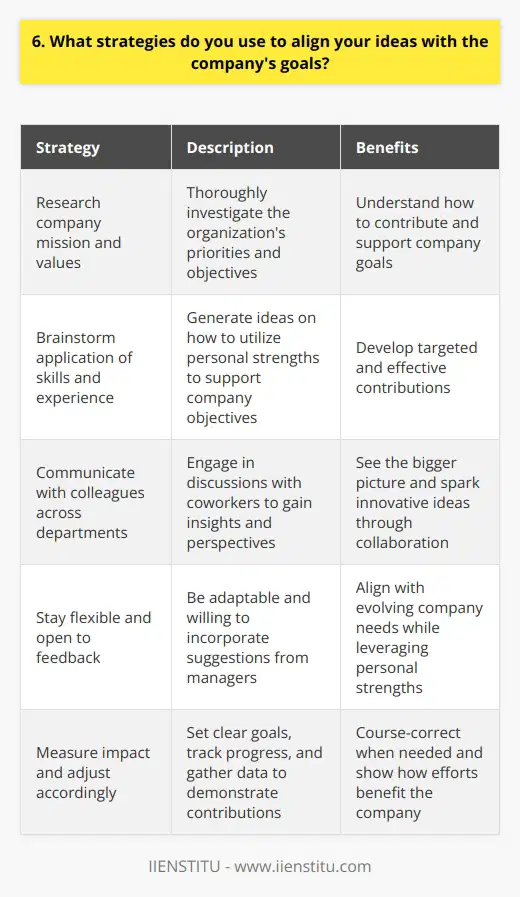
7. Have you ever had to persuade upper management to allocate resources to your project? How did you go about it?
In my previous role as a project manager, I faced a situation where I needed to secure additional resources for my project. I carefully analyzed the project requirements and identified the specific resources needed to ensure success.
Building a Strong Case
I gathered data and created a detailed report highlighting the project's potential impact on the company's bottom line. I focused on the long-term benefits and return on investment, using concrete examples and projections.
Identifying Key Stakeholders
Next, I identified the key stakeholders who could influence the decision-making process. I set up one-on-one meetings with each of them to discuss the project's importance and address any concerns they had.
Presenting to Upper Management
Armed with a strong case and the support of key stakeholders, I requested a meeting with upper management. During the presentation, I clearly outlined the project's objectives, benefits, and resource requirements. I was prepared to answer tough questions and provide further details.
Demonstrating Passion and Commitment
Throughout the process, I showcased my passion for the project and my commitment to its success. I believed in what I was doing and made sure that enthusiasm came across in my interactions with management.
The Outcome
By presenting a well-researched case, involving key stakeholders, and demonstrating my dedication, I was able to persuade upper management to allocate the necessary resources. The project went on to be a success, and I learned valuable lessons about effective communication and persuasion in the workplace.
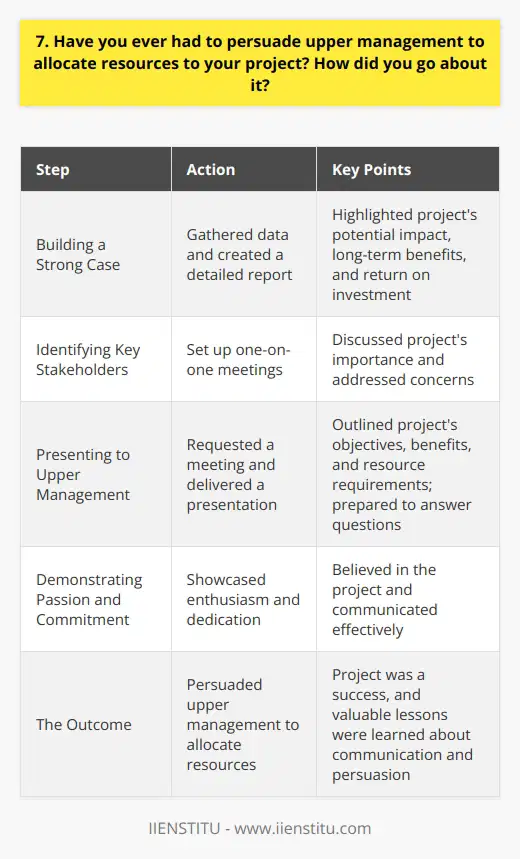
8. Can you discuss a time when you had to negotiate with senior leaders to achieve a desired outcome?
In my previous role as a marketing manager, I had to negotiate with the CEO and CFO to secure additional funding for a crucial advertising campaign. I knew that I needed to present a compelling case backed by data and a clear ROI projection.
Preparing My Pitch
I spent several days gathering market research, analyzing competitor strategies, and calculating the potential return on investment. I wanted to show that the campaign was not only necessary but would also deliver measurable results.
Presenting with Confidence
During the meeting, I presented my findings with enthusiasm and confidence. I highlighted the key benefits of the campaign and addressed any potential concerns upfront. I was prepared to answer tough questions and provide alternative solutions if needed.
Finding Common Ground
Despite some initial hesitation, I listened carefully to the senior leaders' perspectives and tried to find common ground. I emphasized how the campaign aligned with the company's overall goals and values. By showing empathy and flexibility, I was able to build trust and rapport.
Achieving a Successful Outcome
After some back-and-forth discussion, we reached a compromise. The CEO agreed to provide partial funding for the campaign, with the understanding that I would closely monitor the results and report back regularly. In the end, the campaign was a success, and I learned valuable lessons about effective negotiation and collaboration with senior leadership.
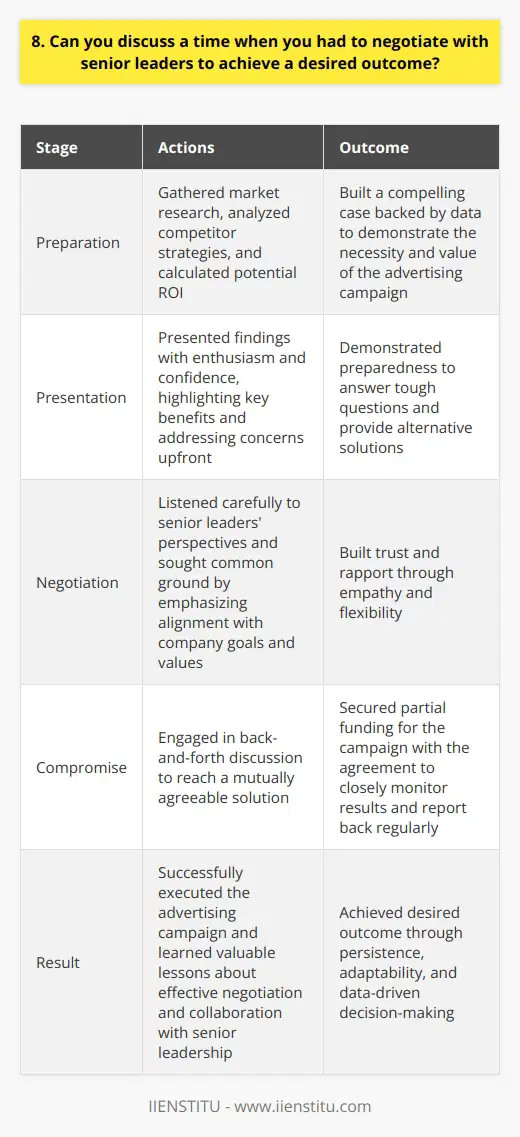
9. How do you prepare yourself before presenting a proposal to upper management?
Preparing for a presentation to upper management is crucial. I start by thoroughly researching the topic and gathering relevant data. This helps me understand the subject matter inside out and anticipate any questions that may arise.
Crafting the Presentation
Next, I create an outline of the key points I want to cover. I structure the presentation in a logical flow, ensuring each section builds upon the previous one. Visual aids like slides, graphs, and charts help convey complex information effectively.
Practicing the Delivery
Practice is essential. I rehearse the presentation multiple times, focusing on my tone, pace, and body language. I ask colleagues for feedback and incorporate their suggestions. This boosts my confidence and helps me deliver the proposal with clarity and conviction.
Anticipating Questions
I also prepare for potential questions. I brainstorm queries the management might have and formulate thoughtful responses. This demonstrates my deep understanding of the subject and my ability to think on my feet.
Final Preparations
On the day of the presentation, I arrive early to set up and test any equipment. I dress professionally and ensure I have all necessary materials. Taking a few deep breaths helps me stay calm and focused.
In my experience, thorough preparation is the key to a successful presentation. It allows me to communicate my ideas effectively, address concerns, and secure the support of upper management.

10. Have you ever had to convince upper management to take a risk? How did you mitigate their concerns?
In my previous role as a marketing manager, I had to convince upper management to invest in a new social media campaign. I knew it was a risk, but I believed it could greatly increase our brand awareness and customer engagement.
Addressing Their Concerns
I anticipated their concerns about the cost and potential ROI. To mitigate these worries, I prepared a detailed proposal that outlined the campaign strategy, budget, and projected results. I also included case studies of similar successful campaigns from other companies in our industry.
Emphasizing the Benefits
During my presentation to management, I focused on the long-term benefits of the campaign. I explained how it could help us reach new audiences, strengthen customer loyalty, and ultimately drive more sales. I was passionate about the idea and let my enthusiasm shine through.
Collaborating with the Team
To further alleviate their concerns, I proposed a collaborative approach. I suggested involving key stakeholders from different departments in the planning and execution of the campaign. This way, we could leverage their expertise and ensure everyone was on board with the strategy.
The Outcome
In the end, my thorough preparation and persuasive argument convinced management to green-light the campaign. It was a success, resulting in a 30% increase in website traffic and a 20% boost in sales. I was proud of the outcome and grateful for the opportunity to take a calculated risk that paid off for the company.
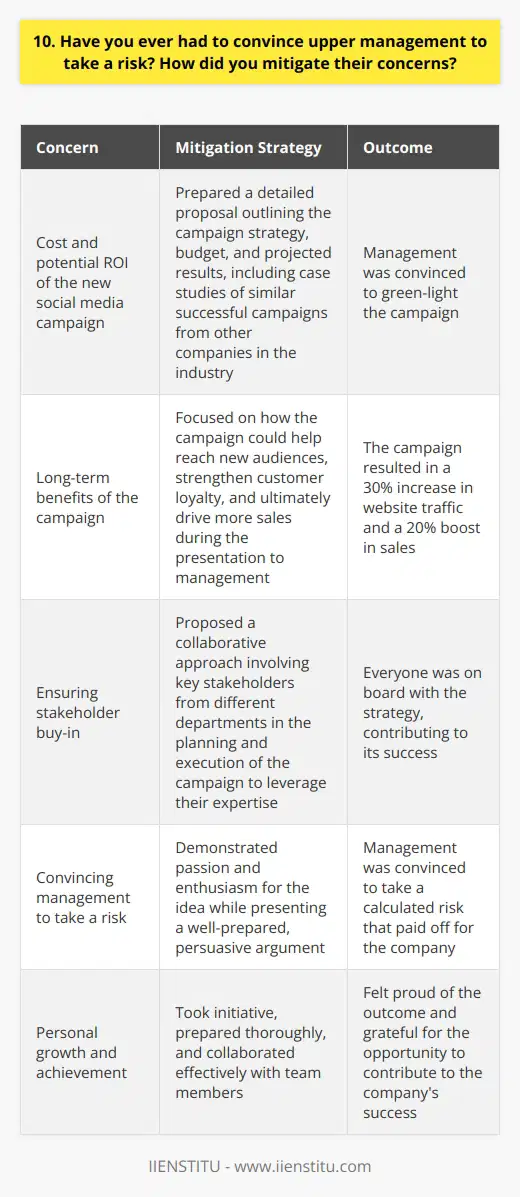
11. Can you describe a situation where you influenced a change in the company's strategy?
In my previous role as a marketing manager, I noticed that our social media strategy was not generating enough engagement. I took the initiative to research our target audience and analyze competitor strategies. Based on my findings, I proposed a new approach that focused on creating more interactive content and leveraging influencer partnerships.
Presenting the Strategy
I presented my ideas to the leadership team, backing up my recommendations with data and case studies. I emphasized how this shift in strategy could improve our brand visibility and customer loyalty. After some discussion, they agreed to give my plan a try.
Implementing the Changes
I worked closely with my team to implement the new strategy. We brainstormed creative content ideas and reached out to relevant influencers. It was a learning process, but we adapted quickly and started seeing positive results within a few months.
The Outcome
Our social media engagement rates increased by 30%, and we gained a significant number of new followers. The influencer partnerships also opened up new opportunities for collaborations and expanded our reach. The leadership team was impressed with the results and decided to allocate more resources to our social media efforts.
Lessons Learned
This experience taught me the importance of staying proactive and data-driven. By identifying areas for improvement and presenting a well-researched solution, I was able to drive meaningful change within the company. It also highlighted the value of collaboration and being open to new ideas.
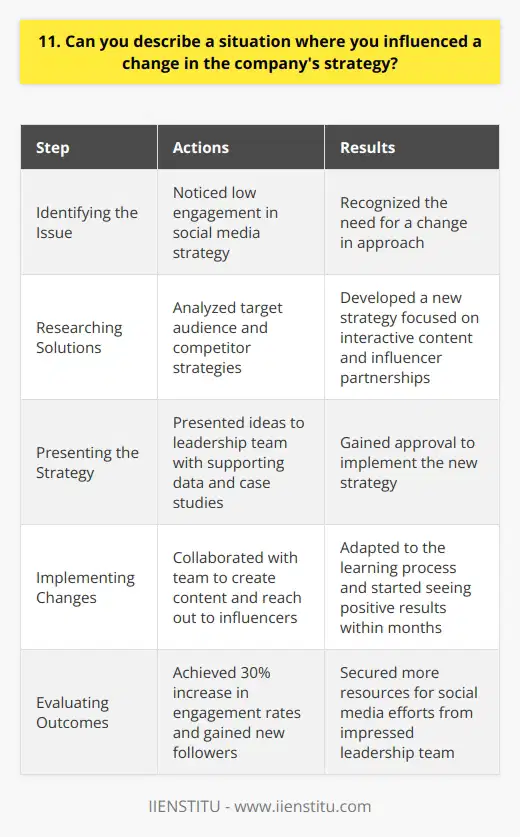
12. How do you build trust and credibility with upper management?
Building trust and credibility with upper management is crucial for career success. Here are some strategies I've found effective:
Communicate openly and honestly
I believe in being transparent and direct in my communications. When I share information, I strive to be accurate and complete. If I make a mistake, I own up to it promptly. Managers appreciate knowing they can rely on what I say.
Follow through on commitments
Whenever I commit to a task or deadline, I make sure to deliver as promised. There have been times where unexpected challenges popped up, but I always communicated proactively and worked hard to still meet the objectives. Consistently following through helps demonstrate my reliability and builds trust over time.
Offer solutions, not just problems
If I spot an issue, I try to brainstorm some potential solutions before raising it to management. They appreciate that I put thought into resolving challenges, instead of just pointing out problems. I've found that a solutions-oriented mindset shows I'm invested in the company's success.
Respect others' time and expertise
Senior leaders have a lot on their plates. I aim to be concise in meetings and emails, while still providing needed context. If a topic is outside my knowledge area, I'll tap internal experts rather than waste management's time. Respecting everyone's time and skills has helped me build positive relationships cross-functionally.
At the end of the day, trust and credibility come from consistently acting with competence and integrity. That's what I strive to bring to all my working relationships, especially with leadership. Let me know if you have any other questions!
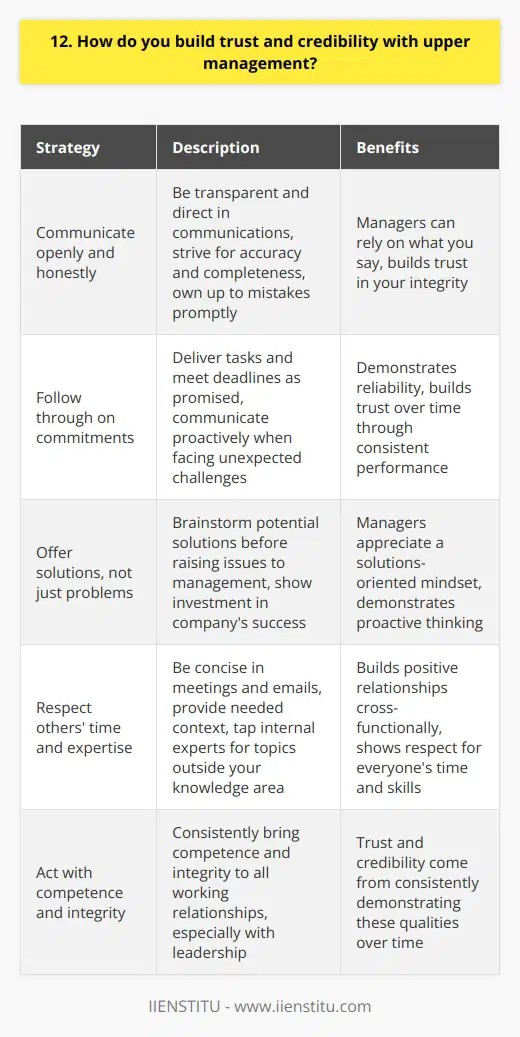
13. Have you ever had to mediate a conflict between upper management and your team? How did you handle it?
In my previous role as a team lead, I encountered a situation where my team and upper management had conflicting priorities. The management wanted us to focus on a new project, while my team felt that we needed to address critical issues with our existing systems first.
Listening to Both Sides
I scheduled separate meetings with my team and management to fully understand their perspectives and concerns. Active listening was key to gathering all the necessary information and showing empathy to both parties.
Finding Common Ground
After hearing everyone out, I realized that both sides had valid points. I looked for areas of agreement and identified the underlying goals that everyone shared – delivering quality products and ensuring long-term success.
Proposing a Compromise
I developed a plan that addressed the critical issues while still making progress on the new project. It involved allocating resources efficiently and setting realistic timelines. I presented this proposal to both my team and management, emphasizing how it aligned with our common objectives.
Communicating and Collaborating
Throughout the process, I maintained open lines of communication between my team and management. I regularly provided updates and facilitated collaboration between the two groups. This helped build trust and fostered a sense of working towards the same goals.
In the end, by actively listening, finding common ground, and proposing a mutually beneficial solution, I was able to successfully mediate the conflict and keep everyone motivated and productive. It was a challenging experience but one that taught me valuable lessons in communication, problem-solving, and leadership.
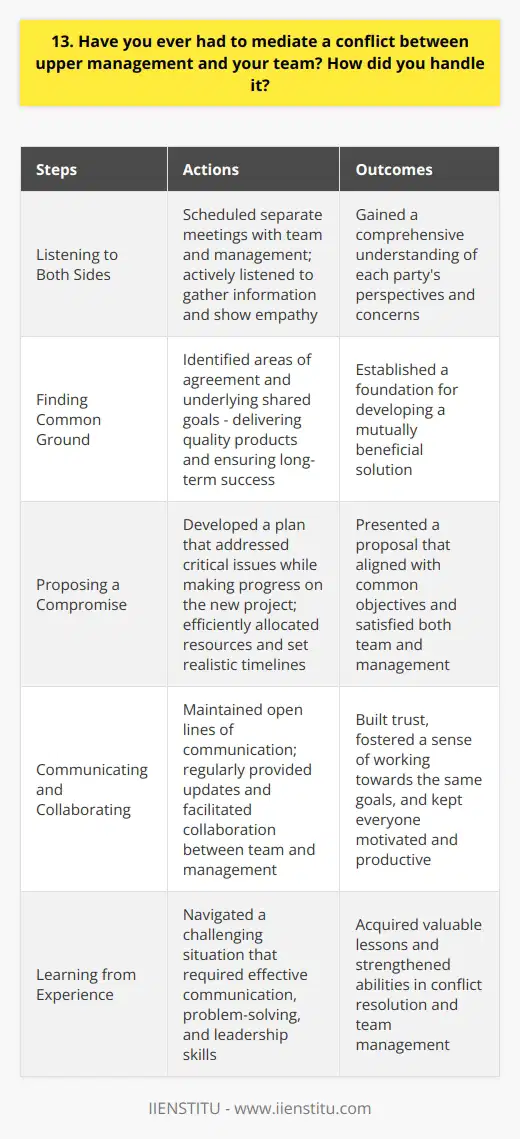
14. Can you provide an example of when you persuaded upper management to invest in a new technology or process?
In my previous role as a software developer, I identified an opportunity to streamline our development process. After researching various options, I discovered a new cloud-based platform that could significantly reduce our development time and costs.
Building a Strong Case
To convince upper management, I needed to build a strong case. I gathered data on the potential time and cost savings, as well as case studies from other companies that had successfully implemented the platform. I also highlighted how the platform could improve collaboration among our remote team members.
Presenting to Management
I requested a meeting with our CTO and VP of Engineering to present my findings. During the presentation, I clearly outlined the benefits of the new platform and addressed any potential concerns they had. I emphasized how the investment would pay off in the long run by increasing our efficiency and competitiveness.
Successful Implementation
After some deliberation, upper management decided to invest in the new platform. I took the lead in implementing it across our development team, providing training and support to ensure a smooth transition. The results were even better than I had anticipated – we saw a 25% reduction in development time and a 15% decrease in costs within the first six months.
This experience taught me the importance of staying up-to-date with new technologies and being proactive in bringing ideas to the table. It also strengthened my ability to communicate complex technical concepts to non-technical stakeholders and advocate for changes that can benefit the company as a whole.
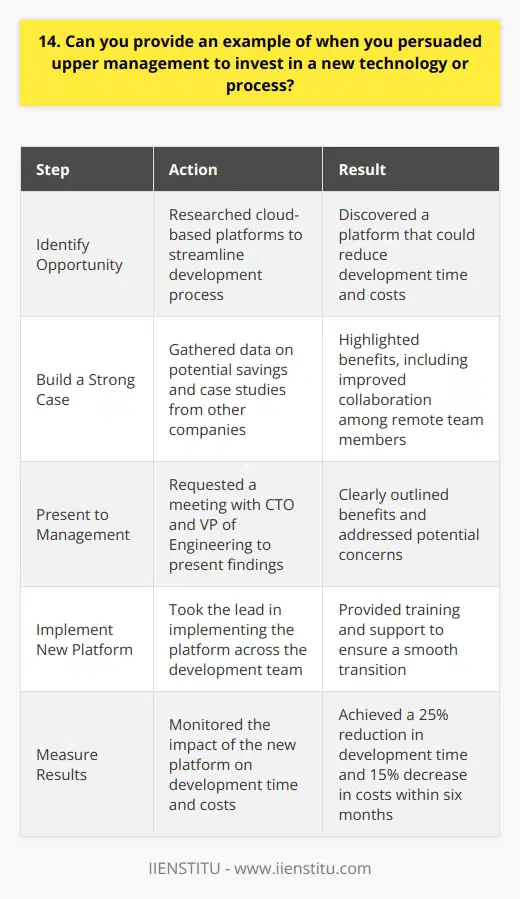
15. How do you ensure that your ideas resonate with the priorities of upper management?
When presenting ideas to upper management, I always make sure to align them with the company's strategic goals and priorities. By thoroughly researching and understanding the organization's objectives, I can frame my proposals in a way that demonstrates their value and potential impact.
Communicating the Benefits
I focus on clearly communicating the benefits of my ideas, highlighting how they can improve efficiency, reduce costs, or drive growth. Using concrete examples and data to support my arguments, I make a compelling case for why my suggestions are worth considering.
Collaborating with Stakeholders
Additionally, I engage with key stakeholders across different departments to gather their insights and perspectives. By incorporating their feedback and addressing any concerns they may have, I can refine my ideas and build broader support for them within the organization.
Adapting to Feedback
I also remain open to feedback and willing to adapt my proposals based on the input of upper management. By being flexible and responsive to their guidance, I can ensure that my ideas are not only innovative but also feasible and aligned with the company's direction.
Ultimately, by taking a strategic, collaborative, and adaptable approach, I am able to develop ideas that resonate with the priorities of upper management and contribute to the success of the organization.
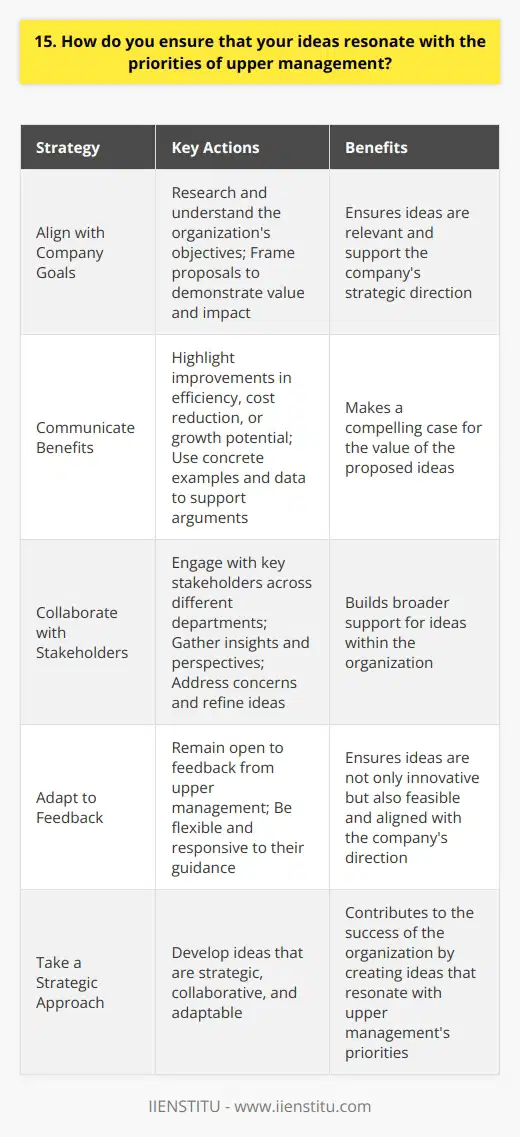
16. Have you ever had to convince upper management to change a policy or procedure? What was your approach?
In my previous role as a Marketing Coordinator, I successfully convinced upper management to change our email marketing policy. I approached the situation by first gathering data on our current open and click-through rates, which were lower than industry benchmarks. Next, I researched best practices and compiled a list of recommended changes, such as optimizing subject lines and segmenting our audience.
Presenting a Compelling Case
I created a presentation highlighting the potential benefits of implementing these changes, including increased engagement and revenue. During the meeting with upper management, I confidently presented my findings and recommendations, backing them up with strong evidence and examples from other successful companies in our industry.
Addressing Concerns and Objections
I anticipated potential concerns and objections from management and came prepared with solutions. For example, I acknowledged that implementing these changes would require additional time and resources, but I outlined a step-by-step plan to minimize disruption and ensure a smooth transition.
Collaborating with Stakeholders
Throughout the process, I collaborated with stakeholders from different departments to gather their insights and support. By involving them in the decision-making process, I built consensus and ensured buy-in from key players.
Achieving Successful Results
As a result of my efforts, upper management approved the proposed changes to our email marketing policy. We implemented the new strategies, and within three months, our open rates increased by 20%, and click-through rates doubled, leading to a significant boost in sales.
This experience taught me the importance of data-driven decision-making, effective communication, and collaboration when convincing upper management to embrace change.
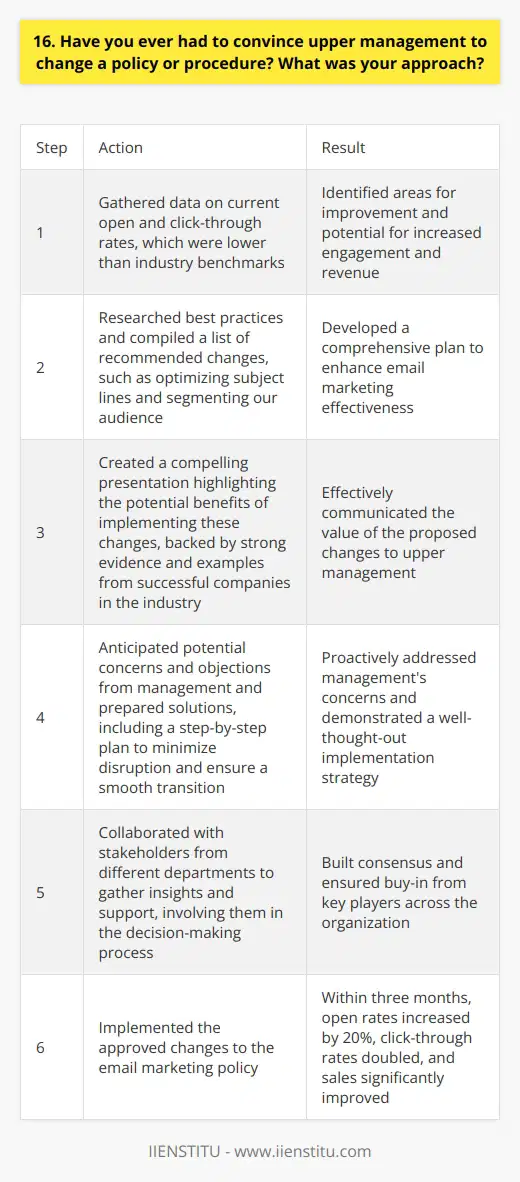
18. How do you tailor your communication style when interacting with senior executives?
When communicating with senior executives, I adapt my style to match their preferences and the situation. I strive to be concise and focused, providing key information without unnecessary details. Active listening is crucial to understand their priorities and tailor my message accordingly.
Adjusting to Executive Communication Preferences
I've learned that some executives prefer data-driven discussions, while others appreciate a more conversational approach. By observing their communication style and asking colleagues for insights, I can better align my own style to their expectations. Flexibility and adaptability are essential.
Focusing on Strategic Priorities
Senior executives often have limited time, so I prioritize discussing strategic issues that impact the company's goals. I avoid getting bogged down in tactical details unless specifically asked. Preparation is key to having productive conversations and anticipating their questions.
Conveying Confidence and Expertise
When presenting to senior leaders, I project confidence in my knowledge and abilities while remaining humble and open to feedback. I practice my presentations to deliver information clearly and concisely. Visual aids can help reinforce key points and keep the discussion on track.
Ultimately, effective communication with senior executives requires emotional intelligence, adaptability, and a strategic mindset. By tailoring my approach to their individual styles and focusing on what matters most to the company, I can build stronger relationships and contribute more effectively to organizational success.
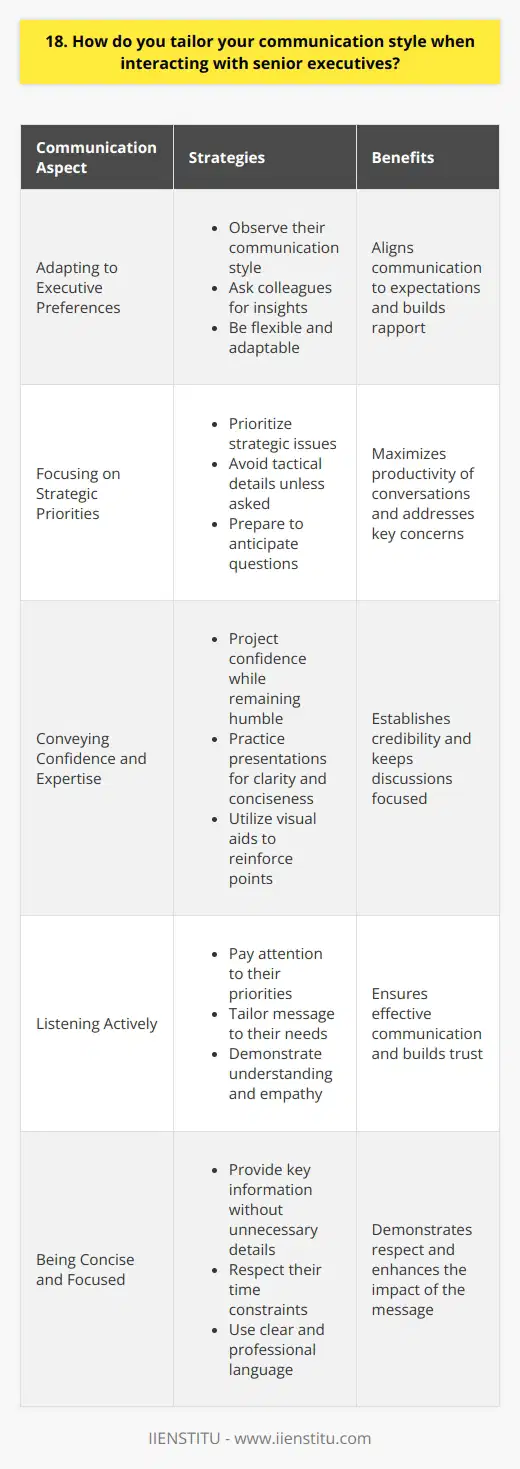
19. Have you ever had to persuade upper management to support an unconventional idea? How did you make your case?
In my previous role as a marketing coordinator, I had an unconventional idea for a social media campaign. The idea was to create a series of humorous memes that showcased our product's unique features. I knew this approach was a bit unorthodox, but I believed it would resonate with our target audience.
Building a Strong Case
To persuade upper management, I first gathered data on the engagement rates of similar campaigns. I also conducted a small focus group to gauge potential reactions to the memes. Armed with this information, I created a detailed proposal that outlined the benefits of the campaign.
Presenting with Confidence
During the presentation, I emphasized how the memes would help us stand out in a crowded market. I also highlighted the potential for increased brand awareness and customer engagement. I was passionate about the idea and made sure to communicate that enthusiasm.
Addressing Concerns
Of course, there were some concerns about the unconventional nature of the campaign. I listened carefully to these concerns and provided thoughtful responses. I acknowledged the risks but also pointed out the potential rewards. I was open to feedback and willing to make adjustments as needed.
Successful Outcome
In the end, upper management was impressed by my thorough preparation and persuasive arguments. They gave the green light for the campaign, which turned out to be a huge success. The memes went viral and generated significant buzz for our product. I was proud of the results and grateful for the opportunity to bring my creative vision to life.
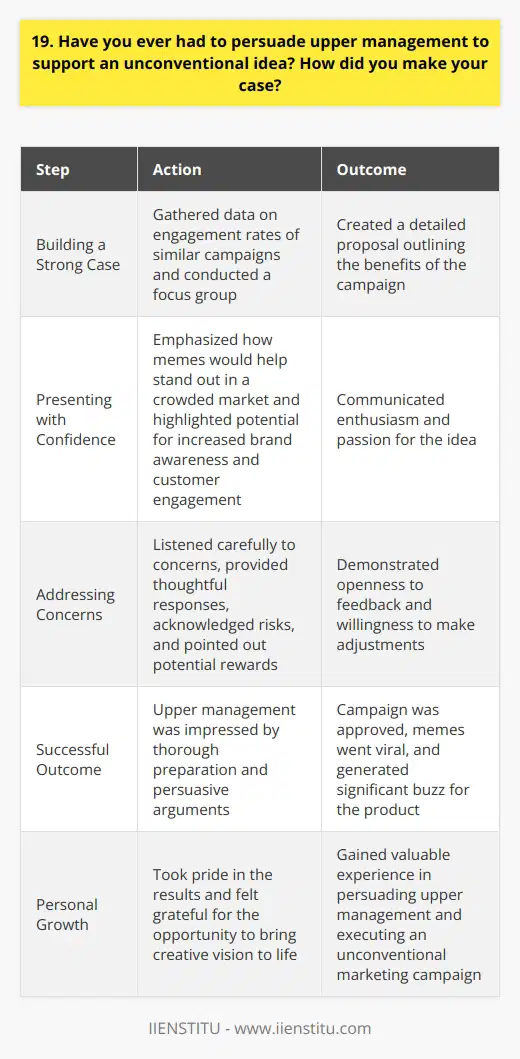
20. Can you describe a time when you had to negotiate a compromise with upper management?
In my previous role as a marketing manager, I faced a situation where I had to negotiate a compromise with upper management regarding our advertising budget. Our team had developed an innovative campaign that required a substantial investment, but the executives were hesitant to allocate the necessary funds.
Understanding the Concerns
I took the initiative to schedule a meeting with the decision-makers to understand their concerns. During the discussion, I actively listened to their reservations and acknowledged the financial constraints the company was facing.
Finding Common Ground
To find a middle ground, I proposed a phased approach to the campaign. We could start with a smaller pilot project to test the effectiveness of our strategy and gather data to support our case for a larger investment in the future.
Presenting Data and Projections
I prepared a detailed presentation highlighting the potential return on investment (ROI) and how the campaign aligned with the company's long-term goals. By providing concrete data and projections, I demonstrated the value of our proposal.
Reaching a Compromise
After several rounds of discussions and negotiations, we reached a compromise. The management agreed to allocate a portion of the requested budget for the pilot project, with the understanding that additional funding would be considered based on the results.
This experience taught me the importance of active listening, finding common ground, and presenting a strong case backed by data. By approaching the negotiation with a collaborative mindset and a willingness to compromise, I was able to secure the resources needed to implement our marketing campaign successfully.
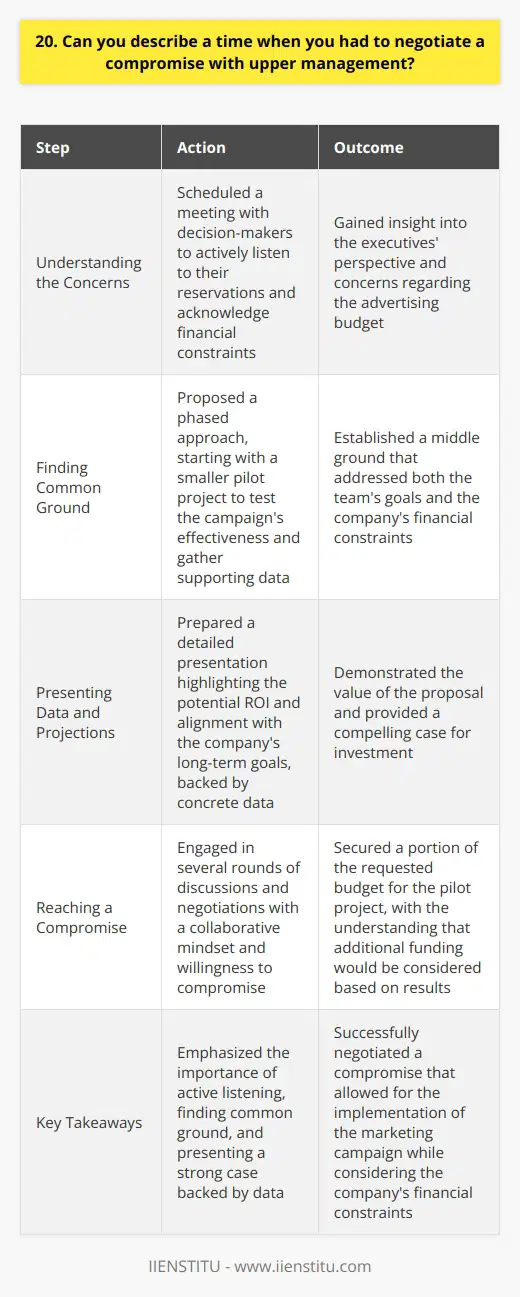
21. How do you establish a strong relationship with upper management?
I believe that establishing a strong relationship with upper management is crucial for success in any organization. Here are some strategies I've found effective:
Communicate Regularly and Proactively
I make an effort to keep my manager informed about my projects, progress, and any challenges I'm facing. I don't wait for them to ask - instead, I proactively share updates through regular check-ins, whether that's a quick chat in the hallway or scheduling a sit-down meeting. Frequent communication helps build trust and shows that I'm engaged and accountable.
Understand Their Goals and Priorities
To really connect with upper management, I try to put myself in their shoes. What are their top objectives and key results? How does my work fit into the bigger picture? By grasping their perspective, I'm able to align my efforts with what matters most to the company. This demonstrates strategic thinking and makes me a more valuable team member.
Deliver Quality Work Consistently
At the end of the day, nothing builds credibility with leadership like consistently producing excellent results. I hold myself to high standards and push myself to overdeliver. When I commit to a deadline or deliverable, I do whatever it takes to follow through, even if it means putting in extra hours. Proving myself reliable and going above and beyond helps me gain the confidence of my bosses.
Be Solutions-Oriented
Whenever I encounter a problem or roadblock, I try to approach my manager not just with the issue but with well-thought-out potential solutions too. Instead of simply pointing out what's wrong, I come to the table with ideas and a can-do attitude. Even if my proposed solution isn't perfect, demonstrating initiative and problem-solving skills sets me apart.
These are some of the ways I'd foster a positive, productive working relationship with upper management. It takes consistent effort and emotional intelligence, but it's well worth the investment for long-term career growth.
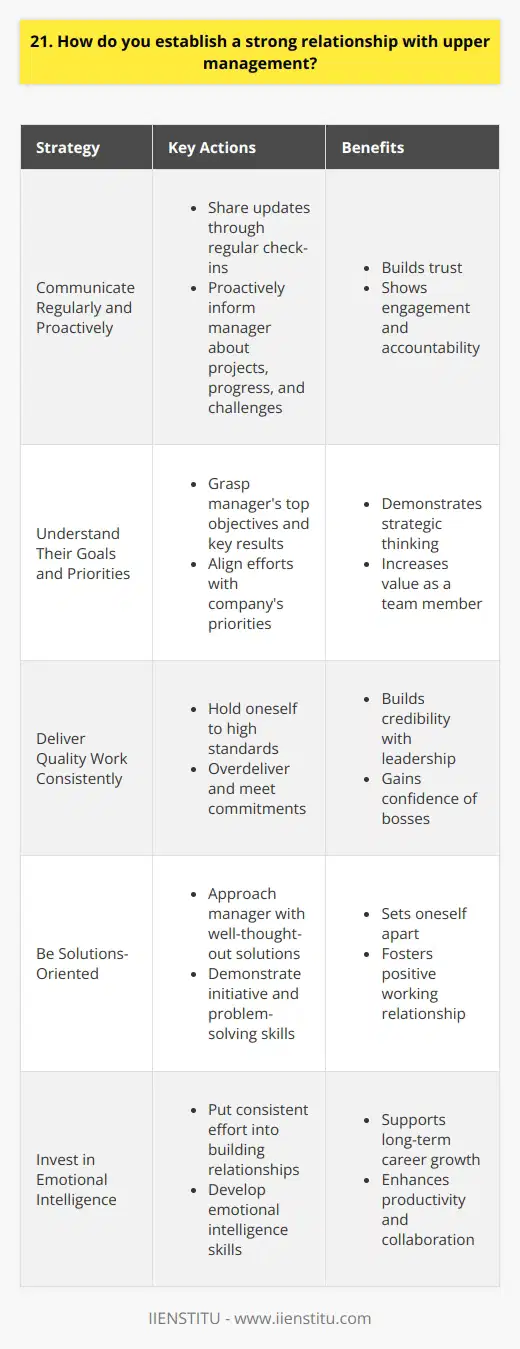
22. Have you ever had to convince upper management to change their perspective on a project or initiative?
In my previous role as a marketing coordinator, I noticed that our social media strategy was outdated and ineffective. I knew that we needed to revamp our approach to reach our target audience and increase engagement.
Gathering Data and Insights
I spent several weeks analyzing our social media metrics, researching industry trends, and gathering feedback from our followers. Armed with this data, I put together a comprehensive presentation highlighting the issues with our current strategy and outlining potential solutions.
Presenting to Upper Management
I approached my manager and requested an opportunity to present my findings to the leadership team. During the presentation, I clearly explained the problems and used data to back up my points. I also showcased successful social media campaigns from our competitors and explained how we could adapt their strategies to fit our brand.
Addressing Concerns and Objections
Initially, some members of the leadership team were resistant to change. They were concerned about the costs and resources required to implement a new strategy. I listened to their concerns and addressed each one, providing solutions and emphasizing the potential ROI of a revamped social media presence.
Collaboration and Implementation
After several discussions, I finally convinced upper management to give my ideas a chance. We worked together to refine the strategy and allocate the necessary resources. Over the next few months, we saw a significant increase in our social media engagement and website traffic, proving that the changes were worthwhile.
Through this experience, I learned the importance of backing up my ideas with data, presenting solutions rather than just problems, and being persistent in the face of resistance. It was a challenging process, but ultimately rewarding to see my ideas come to fruition and make a positive impact on the company.

23. Can you discuss an instance when you successfully influenced upper management to prioritize your team's needs?
In my previous role as a marketing coordinator, I noticed our team was consistently understaffed and overworked. I decided to take action and scheduled a meeting with our department head to discuss the issue.
Preparing a compelling case
Before the meeting, I gathered data on our team's workload and performance metrics. I wanted to present a clear picture of how the lack of resources was impacting our productivity and morale.
Presenting the issue and proposing solutions
During the meeting, I calmly explained the challenges our team was facing. I emphasized that we were dedicated to delivering high-quality work but needed additional support to maintain our standards.
I proposed two potential solutions: hiring an additional team member or redistributing some of our tasks to other departments. I outlined the benefits of each option and how they would contribute to the company's overall success.
Achieving a positive outcome
The department head was receptive to my concerns and appreciated the thought I had put into finding solutions. She agreed that our team needed more support and promised to discuss the matter with upper management.
A few weeks later, we were given approval to hire a new team member. This addition greatly improved our workflow and allowed us to take on new projects without compromising quality.
Lessons learned
Through this experience, I learned the importance of advocating for my team's needs and presenting issues in a constructive manner. By coming prepared with data and potential solutions, I was able to influence upper management and bring about positive change.
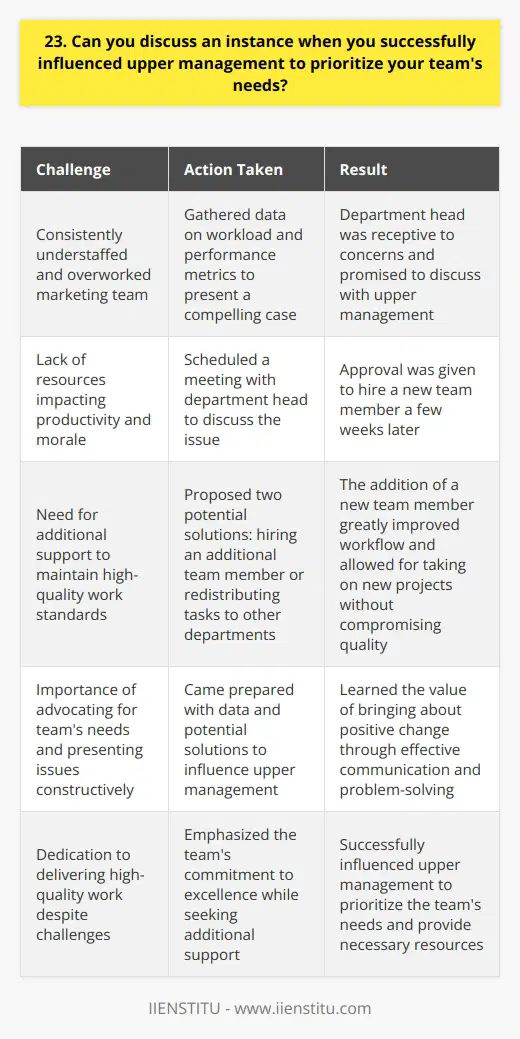
24. How do you ensure that your proposals align with the company's long-term vision?
When preparing proposals, I always start by thoroughly researching the company's mission statement, values, and long-term objectives. This helps me understand where they want to be in the future and how I can contribute to their success.
Aligning with Company Goals
I make sure to highlight how my ideas and strategies directly support the company's goals. For example, when I worked at XYZ Inc., I proposed a new marketing campaign that not only increased short-term sales but also strengthened brand loyalty, which was a key aspect of their long-term vision.
Collaboration and Communication
I believe in collaborating with team members from different departments to gain a holistic perspective. By engaging in open discussions and actively listening to feedback, I can refine my proposals to better align with the company's overall direction.
Adaptability and Flexibility
I understand that a company's vision can evolve over time. That's why I build flexibility into my proposals, allowing room for adjustments as needed. I'm always ready to adapt my approach to ensure continued alignment with the company's goals.
Measurable Results
To demonstrate the effectiveness of my proposals, I set clear, measurable objectives that tie into the company's long-term success metrics. By regularly monitoring and reporting on these metrics, I can show how my work is contributing to the bigger picture.
At the end of the day, I'm passionate about being a strategic partner in helping the company achieve its vision. By staying informed, collaborating with others, and delivering measurable results, I can ensure that my proposals are always in sync with the company's long-term aspirations.

25. Have you ever had to persuade upper management to reconsider a decision they had already made?
In my previous role as a marketing coordinator, I had to persuade upper management to reconsider a decision they had already made. The decision was to cut the budget for a crucial marketing campaign that I believed had the potential to generate significant revenue for the company.
Gathering Evidence
I knew that simply voicing my opinion wouldn't be enough to change their minds. So, I spent several days gathering data and creating a detailed report that highlighted the campaign's potential ROI, as well as the risks associated with cutting the budget.
Presenting My Case
I requested a meeting with the decision-makers and presented my findings in a clear and concise manner. I emphasized the long-term benefits of the campaign and how it aligned with the company's overall goals.
Addressing Concerns
During the meeting, I actively listened to their concerns and addressed each one with data-backed solutions. I also proposed alternative ways to allocate the budget without compromising the campaign's effectiveness.
Successful Outcome
After a lengthy discussion, the management team agreed to reconsider their decision. They were impressed by my thorough research and passion for the project. In the end, they not only approved the original budget but also allocated additional resources to expand the campaign's reach.
This experience taught me the importance of standing up for what I believe in, even if it means challenging authority. By presenting a well-researched case and being open to feedback, I was able to influence a key decision that had a positive impact on the company's bottom line.

26. Can you provide an example of when you successfully gained upper management's support for a challenging project?
In my previous role as a marketing coordinator, I successfully gained upper management's support for a challenging rebranding project. I knew that this project would require significant resources and buy-in from various departments.
Identifying Key Stakeholders
I started by identifying the key stakeholders who would be impacted by the rebranding initiative. This included our CEO, CFO, and heads of marketing, sales, and product development. I set up individual meetings with each of them to discuss the project's goals and potential benefits.
Preparing a Compelling Presentation
Next, I prepared a compelling presentation that showcased the reasons behind the rebranding and the expected outcomes. I included market research, competitor analysis, and financial projections to support my case. I also highlighted how the rebranding would align with our company's long-term strategic objectives.
Addressing Concerns and Objections
During the presentation, I actively listened to their concerns and objections. I addressed each point with data-driven insights and practical solutions. By showing that I had thoroughly thought through the challenges, I demonstrated my commitment to the project's success.
Collaborating with Cross-Functional Teams
After securing upper management's support, I collaborated with cross-functional teams to develop a detailed implementation plan. I regularly communicated progress updates and milestones to keep everyone informed and engaged.
Thanks to the collective efforts of the team and the support from upper management, we successfully executed the rebranding project. The new brand identity resonated well with our target audience, leading to increased brand recognition and customer loyalty.
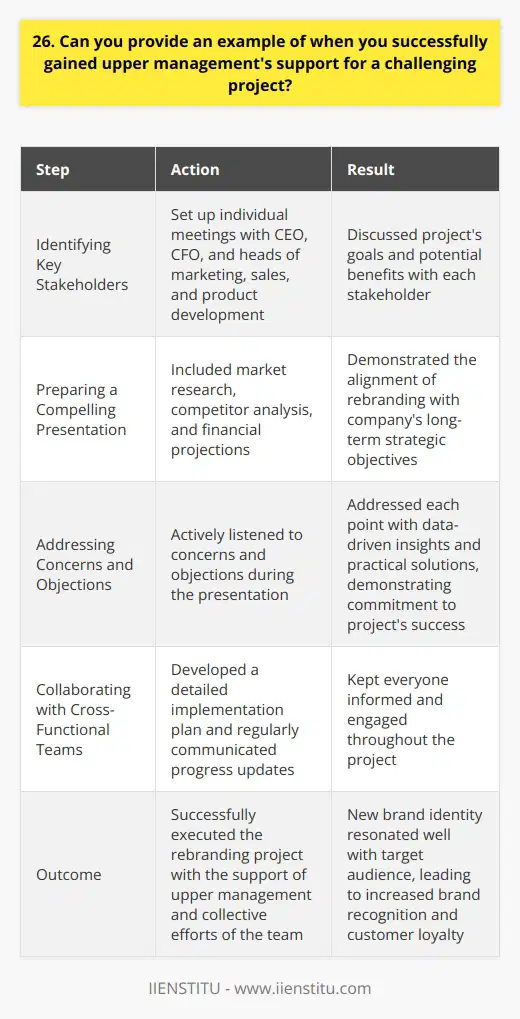
27. How do you communicate the potential impact and benefits of your ideas to upper management?
When communicating the potential impact and benefits of my ideas to upper management, I focus on three key areas. First, I clearly explain how my ideas align with the company's goals and objectives. By demonstrating this connection, I show that my proposals are not just personal preferences but strategic initiatives that support the organization's mission.
Highlighting Tangible Benefits
Next, I highlight the tangible benefits that my ideas can bring to the company. Whether it's increasing efficiency, reducing costs, or improving customer satisfaction, I provide concrete examples and data to support my claims. I use real-world case studies and industry benchmarks to illustrate the potential impact of my ideas.
Addressing Concerns and Risks
Finally, I proactively address any concerns or risks associated with my ideas. I acknowledge potential challenges and present well-thought-out solutions to mitigate them. By being transparent and realistic, I build trust and credibility with upper management.
Tailoring Communication Style
Throughout the process, I tailor my communication style to the preferences of upper management. I use language that resonates with them and focus on the aspects that matter most to their decision-making process. I also listen actively to their feedback and incorporate their insights into my proposals.
Continuous Improvement
Communicating ideas effectively to upper management is an ongoing process. I continuously refine my approach based on their reactions and the results achieved. By staying adaptable and responsive, I ensure that my ideas have the best chance of being adopted and implemented successfully.
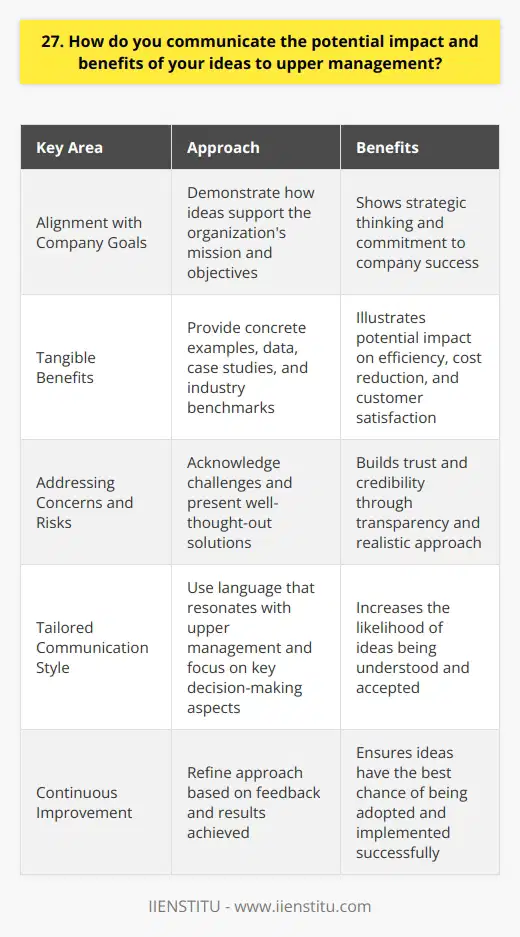
28. Have you ever had to convince upper management to invest in the development of your team members?
Yes, I have had to convince upper management to invest in the development of my team members. It's a crucial part of being a leader and ensuring the long-term success of the team.
Identifying Growth Opportunities
I always keep an eye out for areas where my team members can grow and improve. When I spot potential, I make note of it and consider how we could nurture that talent.
For example, I once had a team member who showed a real knack for public speaking. I knew with some training and experience, they could become a fantastic presenter for our company.
Building a Case
When I've identified a growth opportunity, I start gathering evidence to support my case. I document the team member's strengths, their potential impact on the company, and the specific training or resources they would need.
I also consider the return on investment. Will this development lead to increased productivity, innovation, or revenue? I make sure to highlight these benefits when presenting my case to upper management.
Presenting to Upper Management
When I feel confident in my case, I request a meeting with the relevant decision-makers. I come prepared with a clear plan, supporting evidence, and a persuasive argument.
I focus on the potential outcomes and make it clear how the investment will benefit the company as a whole. I also listen to their concerns and am ready to address any questions or objections they may have.
Following Through
If I get the green light, I make sure to follow through on my plan. I work with the team member to secure the necessary resources and support their development journey.
I keep upper management informed of our progress and the impact of their investment. This builds trust and makes it easier to advocate for team development in the future.
In the end, convincing upper management to invest in your team is about demonstrating the value and potential impact of your proposal. With a strong case and a commitment to follow-through, it's possible to secure the resources your team needs to grow and succeed.
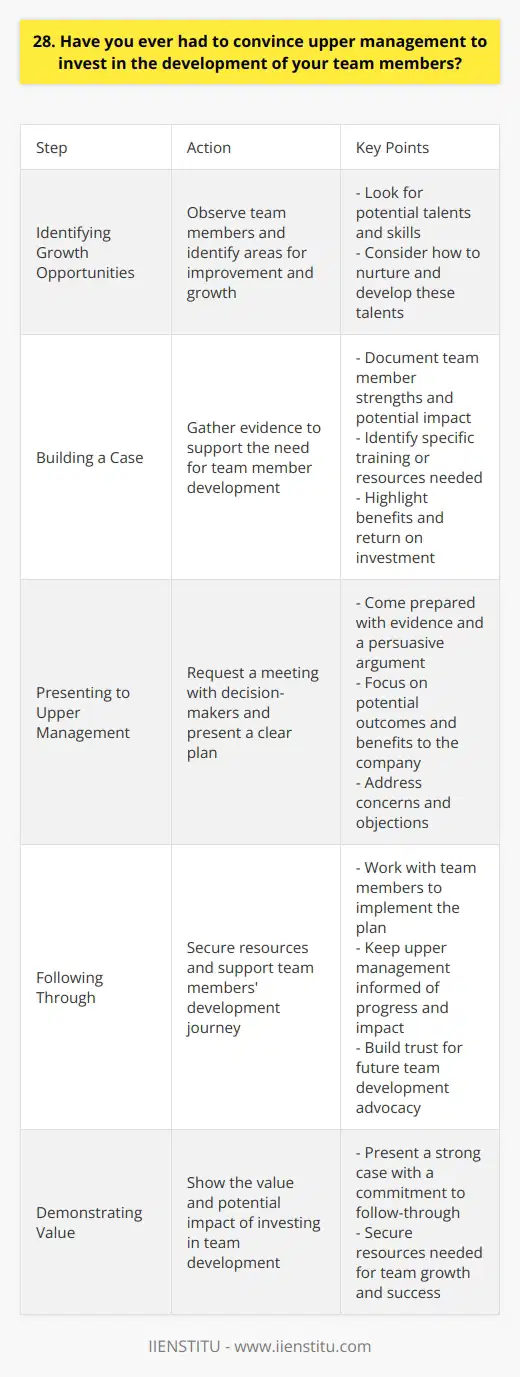
30. How do you maintain the trust and support of upper management over time?
Throughout my career, I've learned that maintaining the trust and support of upper management is crucial for long-term success. It's not always easy, but I've found a few key strategies that have worked well for me.
Communicate Clearly and Consistently
I make it a priority to keep my managers in the loop about my projects and progress. Regular check-ins, whether in person or via email, help ensure everyone stays on the same page. I'm also proactive about sharing both successes and challenges.
When issues arise, as they inevitably do, I bring them to my manager's attention promptly. Together we brainstorm solutions. This open communication builds trust over time.
Deliver Quality Work
At the end of the day, consistently producing high-caliber work is one of the best ways to maintain confidence from above. I hold myself to high standards and always aim to submit my best effort.
If I'm unsure about something, I ask questions. I'd much rather take a little extra time upfront to get clarity than have to redo work later. Quality and reliability go a long way.
Demonstrate Integrity and Ownership
I believe strongly in taking responsibility for my work, both the triumphs and the slip-ups. If I make a mistake, I own up to it, apologize, and present a plan to remedy the situation and prevent future occurrences.
My managers know they can count on me to be transparent and act with integrity. Trust is hard to gain but easy to lose, so I'm very mindful of keeping my word and following through on commitments.
At the end of the day, I've found no shortcuts. Building trust with upper management takes time, consistency and a lot of care and feeding of those key relationships. But when done right, it pays dividends for everyone involved.
